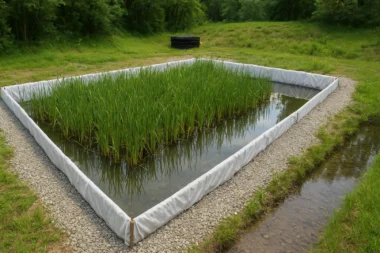Introduction
Passive water treatment systems are environmentally friendly because they use natural processes and materials to treat contaminated water. These systems rely on naturally occurring physical, chemical, and biological processes to remove or reduce contaminants present in water, such as heavy metals, acidity, or excess nutrients. Here’s an introduction to how passive water treatment systems work:
1. Constructed Wetlands: Constructed wetlands are one passive water treatment system type. They mimic the natural processes that occur in wetlands to treat water. Water flows through shallow, marshy areas filled with plants, microorganisms, and various substrates. The plants and their associated microbes help remove contaminants through adsorption, filtration, precipitation, and microbial degradation. The wetland’s porous substrate also promotes the growth of beneficial bacteria that further break down pollutants.
2. Permeable Reactive Barriers: Permeable reactive barriers (PRBs) are another passive treatment system commonly used to treat contaminated groundwater. PRBs consist of a trench or a wall filled with reactive materials, such as iron filings or organic carbon compounds. As groundwater flows through the barrier, contaminants come into contact with the reactive materials. Chemical reactions occur, leading to the immobilization, transformation, or removal of the pollutants. For example, iron filings can chemically bind with heavy metals, reducing their concentration in the water.
3. Bioremediation Ponds: Bioremediation ponds, or lagoons, are shallow, engineered basins designed to enhance the natural microbial degradation processes. They are typically used to treat wastewater containing organic pollutants, such as petroleum hydrocarbons. The ponds provide an environment suitable for microbial activity, including oxygen and nutrients. Microbes present in the water break down the pollutants through biochemical reactions, converting them into less harmful substances.
4. Passive Settling Ponds: Passive settling ponds are simple treatment systems that rely on gravity to remove suspended particles and sediment from water. Water enters the ponds, where it is retained for an extended period. During this time, heavier particles settle to the bottom due to gravity, while lighter particles remain suspended or float. Over time, the settled particles form a sludge layer that can be removed periodically. This process effectively eliminates sediments and associated contaminants from the water.
5. Phytoremediation Systems: Phytoremediation involves using plants to remove, degrade, or immobilize contaminants in water or soil. Plants absorb pollutants through their roots or accumulate them in their tissues. In the case of water treatment, plants can extract metals or organic compounds from the water. The plant’s metabolic processes can store or transform the contaminants in the biomass. Phytoremediation systems can be designed using various plant species and configurations, such as floating aquatic plants or constructed wetlands.
Passive water treatment systems are favored for their low energy requirements, cost-effectiveness, and minimal maintenance needs. However, their efficiency and suitability depend on the specific contaminants present, water quality parameters, and site conditions. Proper system design, monitoring, and periodic maintenance are essential to ensuring optimal performance and long-term effectiveness.
Process of treating contaminated water and materials required
Treating contaminated water can vary depending on the type and level of contamination and the specific treatment system used. However, here is a general overview of the steps involved and some common materials that may be required:
1. Preliminary Assessment: The first step is to assess the nature and extent of contamination in the water. This may involve collecting water samples and conducting laboratory tests to identify the contaminants present and determine their concentrations.
2. System Design: Based on the assessment, a treatment system is designed to address the specific contaminants. The treatment system selection depends on factors such as the type and concentration of contaminants, water flow rate, site conditions, and regulatory requirements.
3. Pre-Treatment: In many cases, pre-treatment steps are necessary to remove or reduce specific contaminants before the water enters the central treatment system. Standard pre-treatment processes include sedimentation (allowing particles to settle out), filtration (removing suspended solids through a physical barrier), or pH adjustment (raising or lowering the water’s acidity or alkalinity).
4. Main Treatment: This step involves the core treatment process for removing or reducing contaminants. Different treatment methods may be employed, such as:
Adsorption: using adsorbent materials like activated carbon, zeolite, or specialty resins to attract and bind contaminants to their surfaces.
Filtration: passing water through media filters (e.g., sand, gravel, or mixed media) to physically trap particles and remove impurities.
Chemical Precipitation: Adding chemical agents (e.g., lime or coagulants) to induce the precipitation of contaminants, forming solid particles that can be separated.
Biological Treatment: Utilising microorganisms (e.g., bacteria or algae) to break down organic pollutants through processes like biodegradation or photosynthesis
Oxidation/Reduction: Applying chemical oxidants (e.g., chlorine or ozone) or reducing agents (e.g., sulfur compounds) to transform contaminants into less harmful forms
Ion Exchange: Exchanging undesirable ions in the water with more desirable ones by passing the water through ion exchange resins
Reverse osmosis: using a semi-permeable membrane to separate contaminants from water by applying pressure, allowing only clean water molecules to pass through.
5. Post-Treatment: Additional steps may be required to enhance water quality further or adjust specific parameters after the primary treatment process. This could involve disinfection (e.g., chlorination or UV irradiation) to kill remaining pathogens, pH adjustment, or the addition of stabilizing chemicals.
6. Monitoring and Quality Control: Regular monitoring of water quality parameters is crucial to ensuring the treatment system’s effectiveness throughout the treatment process. This may involve measuring pH, turbidity, dissolved oxygen, specific contaminants, and other relevant indicators. Based on monitoring results, adjustments to the treatment process or additional materials may be necessary.
Materials required for treating contaminated water can vary depending on the treatment method. Some common materials include:
- Adsorbents: activated carbon, zeolite, specialty resins
- Filter media: sand, gravel, mixed media, membranes
- Chemical agents: coagulants, lime, oxidants, reducing agents, disinfectants
- Biological cultures: bacteria, algae, enzymes
- Ion exchange resins
- pH adjustment chemicals: acid or alkali solutions
- Monitoring equipment: pH meters, turbidity meters, spectrophotometers, etc.
Removal and reduction of containment from water
The science behind passive water treatment systems lies in harnessing natural processes to remove or reduce contaminants in water. These systems rely on physical, chemical, and biological mechanisms to achieve water treatment objectives. Here’s a closer look at the science behind each of these processes:
1. Physical Processes:
Sedimentation: Sedimentation is based on the principle of gravity. Heavier particles and solids in water settle to the bottom due to their greater mass, forming a sediment layer. This process effectively removes larger particles, suspended solids, and sediments from the water.
Filtration: Filtration is a physical process that involves passing water through a medium that acts as a physical barrier. The filter medium can comprise sand, gravel, or membranes with specific pore sizes. The filter media physically traps and retains suspended particles, colloids, and more significant microorganisms as water flows through it, allowing cleaner water to pass through.
2. Chemical Processes:
Coagulation and flocculation: Coagulation and flocculation involve the addition of chemical coagulants, such as alum or ferric chloride, to water. The coagulants neutralize the surface charges of suspended particles and colloids, causing them to come together and form larger aggregates called flocs. This process is facilitated by forming chemical bonds between the coagulant and the particles. The resulting flocs can be more easily removed through subsequent sedimentation or filtration steps.
Chemical Precipitation: Chemical precipitation is a process in which chemical agents are added to water to induce the formation of insoluble precipitates. The chemicals used can react with dissolved contaminants, such as heavy metals, forming solid particles that settle out of the water. Common examples include the addition of lime (calcium hydroxide) to water containing dissolved metals like iron or manganese, causing them to precipitate as solid particles and facilitating their removal.
Oxidation and reduction: Oxidation and reduction processes involve chemical reactions that alter the chemical composition of contaminants. Oxidation involves adding oxidizing agents, such as chlorine or ozone, to water. These agents react with pollutants, breaking them into less harmful or more easily removable forms. On the other hand, reduction involves adding reducing agents, such as sodium bisulfite, which can convert specific contaminants into less harmful or insoluble forms.
3. Biological Processes:
Biodegradation: Biodegradation is a biological process where microorganisms, such as bacteria or fungi, metabolize organic contaminants as a source of energy or nutrients. These microorganisms produce enzymes that break down complex organic molecules into simpler compounds, such as carbon dioxide, water, and microbial biomass. Biodegradation is particularly effective in treating organic pollutants and can be enhanced through favorable conditions like oxygen availability, a suitable pH, and nutrient availability.
Phytoremediation uses plants and associated microorganisms to remove, degrade, or immobilize contaminants. Plants can uptake contaminants through their root systems and translocate them to their shoots and leaves. The rhizosphere’s (the root zone’s) microbial activity can either help the pollutants undergo transformations or store them in plant tissues. Phytoremediation effectively treats various contaminants, including organic pollutants and heavy metals.
Architecture of passive water treatment systems
1. Inflow and Pre-Treatment:
The water to be treated is directed into the treatment system through an inflow channel or pipe.
Pre-treatment processes may be incorporated to remove larger debris, settleable solids, or other easily separable contaminants. This may include sedimentation basins, settling tanks, or screening mechanisms.
2. Treatment Units:
Treatment units form the core of the passive water treatment system. They are designed to facilitate the desired physical, chemical, and biological processes for contaminant removal.
Standard treatment units include constructed wetlands, bioreactors, permeable reactive barriers, biofilters, or ponds. The selection of treatment units depends on the specific contaminants, water quality parameters, and treatment objectives.
Treatment units are typically designed with specific substrates or media that support the desired processes. For example, constructed wetlands may have gravel, sand, and organic-rich soil layers, while bioreactors may contain specialized media for microbial activity.
3. Flow Control and Distribution:
Water flow through the treatment system is carefully controlled to optimize contact time and treatment efficiency.
Flow control mechanisms, such as weirs, baffles, or flow regulators, ensure water is evenly distributed across the treatment units.
Water may be directed through multiple treatment units in series or parallel, allowing for sequential treatment stages or redundancy to enhance treatment effectiveness.
4. Retention Time and Hydraulic Considerations:
The retention time, or hydraulic residence time, refers to the water’s duration within the treatment system.
The treatment system design considers the desired retention time crucial for allowing sufficient contact between the water and the treatment processes to achieve effective contaminant removal.
The treatment units’ size and capacity, flow rates, and hydraulic characteristics are carefully determined to ensure the desired retention time.
5. Monitoring and Maintenance:
Monitoring systems are often incorporated to assess the performance and effectiveness of the treatment system.
Parameters such as flow rates, water quality (e.g., contaminant concentrations, pH, dissolved oxygen), and system performance indicators (e.g., removal efficiency) may be monitored regularly.
Maintenance activities, such as vegetation management, substrate replacement, or periodic cleaning, are performed to optimize system performance and longevity.
Why passive water treatment?
Passive water treatment systems are favored for several reasons:
1. Environmentally Friendly: Passive water treatment systems rely on natural processes and materials, minimizing using chemicals or energy-intensive processes. They work harmoniously with the environment and can often provide additional benefits, such as habitat creation or biodiversity enhancement.
2. Cost-Effective: Passive systems generally have lower capital and operational costs than conventional treatment methods. They often require less infrastructure, equipment, and maintenance, making them a cost-effective option, particularly for long-term operations.
3. Low Energy Requirements: Passive treatment systems typically operate without external energy sources, reducing operational costs and minimizing the carbon footprint. This makes them suitable for remote areas or locations with limited energy availability.
4. Long-Term Sustainability: Passive systems are designed to work over an extended period without significant interventions. Once established, they can continue to treat water effectively for many years with minimal maintenance. This long-term sustainability makes them suitable for both temporary and permanent applications.
5. Versatility: Passive treatment systems can be designed and adapted to treat contaminants, including heavy metals, organic pollutants, nutrients, and pathogens. Different passive strategies, such as constructed wetlands, permeable reactive barriers, or bioremediation ponds, offer flexibility in addressing specific water quality challenges.
6. Natural Aesthetics and Land Use Integration: Passive treatment systems like constructed wetlands can be visually appealing and blend well with the surrounding landscape. They can serve as aesthetically pleasing features while providing valuable ecosystem services and improving water quality.
7. Regulatory Compliance: Passive treatment systems can help industries and municipalities meet environmental regulations and discharge standards. By effectively removing or reducing contaminants, they enable compliance with water quality requirements and minimize the risk of penalties or legal issues.
8. Resilience and Adaptability: Passive treatment systems often adapt to changing water quality conditions or variations in pollutant concentrations. They can provide stable and reliable treatment performance, even when faced with fluctuations in flow rates or contaminant loads.
Case Study: Constructed Wetland for Contaminated Industrial Runoff
Problem: An industrial facility near a river has been experiencing runoff containing heavy metals and organic pollutants. This runoff threatens the receiving water body and violates environmental regulations.
Solution: The facility implemented a constructed wetland as a passive water treatment system to treat the contaminated runoff before it was discharged into the river. The constructed wetland is designed to promote the natural processes of filtration, adsorption, precipitation, and microbial degradation to remove the contaminants.
Implementation and Results:
1. Design and Construction:
A series of shallow basins are constructed adjacent to the industrial facility.
The basins are lined with impermeable material to prevent seepage and are filled with gravel, sand, and organic-rich soil as the substrate.
Indigenous wetland plants, known for tolerating pollutants, are planted in the basins.
Water from the industrial runoff is directed into the first basin of the constructed wetland system.
2. Contaminant Removal Mechanisms:
Filtration: As water flows through the substrate and among the plant roots, suspended particles, sediments, and larger contaminants are physically filtered and trapped.
Adsorption: The wetland plants and the substrate have surfaces that can adsorb specific contaminants, such as heavy metals, organic compounds, and nutrients.
Precipitation: Chemical reactions occur within the wetland due to specific ions and compounds, leading to heavy metal precipitation and subsequent removal from the water.
Microbial Degradation: Microorganisms associated with the wetland plants and substrate break down organic pollutants through biodegradation processes, converting them into less harmful substances.
3. Monitoring and Evaluation:
Water samples are regularly collected at different points within the wetland system to assess the water quality parameters and contaminant concentrations.
Parameters monitored include heavy metal concentrations, organic pollutant levels, pH, dissolved oxygen, and microbial activity.
The data is compared against regulatory standards to evaluate the effectiveness of the treatment system.
4. Results:
Over time, the constructed wetland system proves to be effective in treating the contaminated industrial runoff.
The filtration process removes suspended solids and sediments, improving water clarity.
The wetland plants and substrate adsorb and accumulate heavy metals and organic compounds, reducing their concentrations in the treated water.
Chemical precipitation processes facilitate the removal of dissolved heavy metals, resulting in lower metal concentrations.
The microbial degradation processes contribute to the breakdown of organic pollutants, improving water quality further.
Regular monitoring shows a significant reduction in contaminant concentrations, with the treated water meeting the required regulatory standards for discharge into the river.
Conclusion
Passive water treatment systems offer a sustainable and environmentally friendly approach to treating contaminated water. These systems effectively remove or reduce contaminants without relying heavily on energy or chemicals by harnessing natural processes such as physical filtration, chemical precipitation, and biological degradation. They provide cost-effective solutions, long-term sustainability, and regulatory compliance while minimizing environmental impact. The versatility and adaptability of passive treatment systems make them suitable for various applications, from industrial wastewater treatment to stormwater management and ecological restoration.



